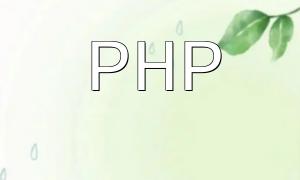In object-oriented programming, the decorator pattern, as a structural design pattern, offers a flexible way to extend the functionality of existing objects without modifying their original code. Through this article, you will gain a deep understanding of how to apply the decorator pattern in PHP and master its core concepts through concrete code examples.
The decorator pattern allows us to dynamically add new functionality to existing objects by "wrapping" them, without changing their structure or behavior. This pattern follows the "open-closed principle," enabling systems to extend object behavior through composition without modifying existing code.
In PHP, implementing the decorator pattern typically involves using interfaces or abstract classes to define the contract between decorators and the objects being decorated. Next, we will demonstrate how to implement this design pattern with a specific example.
Suppose we have a simple text editor class TextEditor that implements a basic display method to show text content.
interface TextEditorInterface {
public function display();
}
<p>class TextEditor implements TextEditorInterface {<br>
protected $text;<br>
public function __construct($text) {<br>
$this->text = $text;<br>
}</p>
echo $this->text;
}
}
In this basic implementation, the text editor simply displays text. But what if we want to add new features like font styles or colors?
To add new functionality to the TextEditor class, we first define a decorator interface TextDecoratorInterface that extends TextEditorInterface, providing a unified interface contract for concrete decorator classes.
interface TextDecoratorInterface extends TextEditorInterface {<br>
}Then, we create a concrete decorator class to modify the font style.
class FontStyleDecorator implements TextDecoratorInterface {<br>
protected $textEditor;</p>
$this->textEditor = $textEditor;
}
public function display() {
echo "<i>" . $this->textEditor->display() . "</i>";
}
}
At this point, we have successfully created a font style decorator that can change the text display style. Next, let's create a color decorator to add color to the text.
class ColorDecorator implements TextDecoratorInterface {<br>
protected $textEditor;</p>
$this->textEditor = $textEditor;
}
public function display() {
echo "" . $this->textEditor->display() . "";
}
}
By combining different decorator classes, we can dynamically add various functionalities without modifying the original TextEditor class. The following code shows how to use decorator composition to add both font style and color to the text editor.
$textEditor = new TextEditor("Hello World!");<br>
$fontStyleDecorator = new FontStyleDecorator($textEditor);<br>
$colorDecorator = new ColorDecorator($fontStyleDecorator);</p>
<p data-is-last-node="" data-is-only-node="">$colorDecorator->display(); // Outputs text with font style and colorThis code demonstrates how the decorator pattern allows adding extra features to an object while keeping the original code unchanged.
The decorator pattern is a powerful design pattern that enables developers to dynamically add new behaviors to objects without modifying existing code. In PHP, the decorator pattern helps achieve flexible feature extensions while ensuring code flexibility and maintainability. Through the explanations and code examples in this article, you should have a better understanding of the decorator pattern’s application and be able to apply this design pattern flexibly in your projects.






